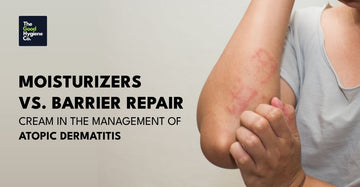Atopic Dermatitis (AD) is more than just dry, itchy skin; it's a chronic, inflammatory skin condition rooted in a defective skin barrier. While moisturizers have long been the go-to for managing dryness and irritation, emerging research is challenging their role as frontline therapy. Enter barrier repair creams formulations that go beyond hydration to correct the skin’s fundamental lipid imbalance.
So, which is better for managing AD: traditional moisturizers or physiologic barrier repair creams? Let’s break it down.
Understanding the Basics: What Happens to the Skin in AD?
In healthy skin, the outermost layer (stratum corneum) acts like a brick wall, with skin cells as bricks and lipids as mortar. This structure keeps moisture in and harmful elements out. In AD, this "mortar" is weakened due to genetic mutations that impair lipid production and delivery, particularly ceramides, cholesterol, and free fatty acids.
As a result, the skin loses water rapidly (transepidermal water loss), becomes dry and inflamed, and is more susceptible to allergens and microbes.
Moisturizers: Symptom Relief Without Fixing the Foundation
How Moisturizers Work
Most moisturizers include three types of ingredients:
- Occlusives (e.g., petrolatum, lanolin): Form a physical barrier on the skin’s surface to prevent water loss.
- Humectants (e.g., glycerin): Draw water from the environment into the skin.
- Emollients (e.g., olive, jojoba, avocado oils): Soften and smooth the skin.
Some formulations may include ceramides or botanical ingredients like chamomile, which offers mild anti-inflammatory effects.
Short-Term Gains, Long-Term Questions
- Occlusives can temporarily relieve dryness and reduce mild inflammation by rehydrating the skin.
- However, moisturizers do not address the lipid imbalance central to AD.
- Worse, in individuals with sensitive or barrier-compromised skin (as in AD), some moisturizers might even worsen the condition by disrupting already fragile barriers, especially if not tested in this specific population.
The Problem with "Ceramide-Containing" Moisturizers
While ceramides are beneficial, many moisturizers contain them in too-low concentrations or without their essential lipid partners (cholesterol and free fatty acids), rendering them ineffective or even counterproductive.
Barrier Repair Creams: Targeting the Root Cause
What Sets Them Apart
Barrier repair creams are designed to restore the skin’s natural lipid balance. They don’t just sit on the surface—they’re absorbed and incorporated into the skin’s lipid-making machinery.
Key features:
- Contain ceramides, cholesterol, and free fatty acids in equimolar or optimized ratios (often 3:1:1).
- Mimic the skin’s natural lipid composition.
- Work within the deeper layers of the skin to help form the lamellar bilayers essential for barrier function.
Why This Matters in AD
- AD skin is deficient in all three major lipids, especially ceramides.
- Topically applying them in the right ratio helps restore barrier function, reduce water loss, and even improve antimicrobial defense.
- These creams can also be formulated at a low pH, which supports enzyme activity essential for lipid production and inhibits inflammation.
Mechanisms of Anti-Inflammatory Action
Unlike moisturizers, barrier repair formulations:
- Normalize skin pH
- Activate enzymes that produce ceramides
Inhibit kallikreins that damage the skin
- Boost antimicrobial peptides (like LL-37)
- Reduce cytokine production and mast cell activation
Are Moisturizers Ever Enough?
While moisturizers offer temporary hydration and can soothe dry, uninvolved skin, they should not be considered stand-alone therapy in active or moderate-to-severe AD. Their benefit is mainly cosmetic or symptomatic.
They work best when:
- Used as supportive care alongside anti-inflammatory treatments.
- Applied to unaffected or mildly dry areas to combat generalized xerosis
However, indiscriminate or poorly formulated moisturizers may disrupt sensitive skin and perpetuate flare-ups—especially those not specifically tested for barrier-compromised conditions.
Therapeutic Strategy:
Here’s how clinicians often manage AD using a combined strategy:
- Initial Phase (Flare Management): Use anti-inflammatory agents (steroids, calcineurin inhibitors) and/or ceramide-dominant barrier creams twice daily on inflamed areas.
- Tapering Phase: As inflammation recedes, reduce anti-inflammatory use and maintain barrier cream application once daily.
- Maintenance Phase: Continue barrier creams on prone-to-flare sites. Use occlusive moisturizers on uninvolved skin to relieve dryness.
This regimen not only helps control active AD but may also prevent rebound flares—as demonstrated in animal models.
Conclusion:
While moisturizers provide basic hydration, their benefits in AD are limited and often overestimated. Barrier repair creams, particularly those containing ceramides, cholesterol, and free fatty acids in optimal ratios, represent a science-backed evolution in AD therapy. They don’t just mask symptoms—they rebuild the skin’s foundation.
If you or your child suffers from AD, speak to your dermatologist about switching to a physiologic lipid-based barrier repair product. It might just be the game-changer your skin needs.
Remember Moisturizers hydrate. Barrier creams heal.
References:
1.Clinical Perspective: Moisturizers vs. Barrier Repair in the Management of Atopic Dermatitis - 2018 - AUg - https://pmc.ncbi.nlm.nih.gov/articles/PMC6289688/#S1






